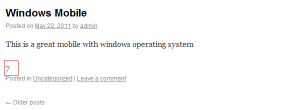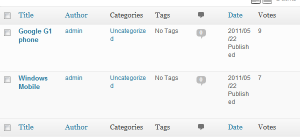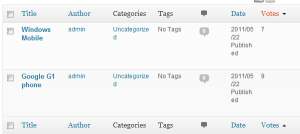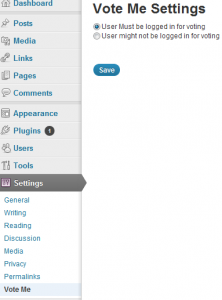- Creating the Plugin
- Adding the vote link to posts
- Adding votes using Ajax
- Customizing WordPress admin to show post votes
- Sorting post on basics of votes in WordPress admin
- Allowing only Registered users to vote
- Creating a widget to display Top voted posts.
- Conclusion.
- Frequently Asked Questions about Creating a Voting Plugin for WordPress
Creating the Plugin
To create a plugin create a file voteme.php in your wp-content/plugins/voteme folder. To create a plugin we have to add the plugin header as follows<?php
/*
Plugin Name: Vote Me
Plugin URI:
Description: This plugin to add vote in posts
Author: Abbas
Version: 0.1
Author URI:
*/define('VOTEMESURL', WP_PLUGIN_URL."/".dirname( plugin_basename( __FILE__ ) ) );
define('VOTEMEPATH', WP_PLUGIN_DIR."/".dirname( plugin_basename( __FILE__ ) ) );function voteme_enqueuescripts()
{
wp_enqueue_script('voteme', VOTEMESURL.'/js/voteme.js', array('jquery'));
wp_localize_script( 'voteme', 'votemeajax', array( 'ajaxurl' => admin_url( 'admin-ajax.php' ) ) );
}
add_action('wp_enqueue_scripts', voteme_enqueuescripts);</pre>
Adding the vote link to posts
Now we will add a link to all the posts displaying the current votes and a link to add the vote by ajax. Following is the codefunction voteme_getvotelink()
{
$votemelink = "";
$post_ID = get_the_ID();
$votemecount = get_post_meta($post_ID, '_votemecount', true) != '' ? get_post_meta($post_ID, '_votemecount', true) : '0';
$link = $votemecount.' <a onclick="votemeaddvote('.$post_ID.');">'.'Vote'.'</a>';
$votemelink = '<div id="voteme-'.$post_ID.'">';
$votemelink .= '<span>'.$link.'</span>';
$votemelink .= '</div>';
return $votemelink;
}
function voteme_printvotelink($content)
{
return $content.voteme_getvotelink();
}
add_filter('the_content', voteme_printvotelink);voteme_getvote link which first gets the current post id and then reads the post meta _votemecount using get_post_meta. We use the post meta _votemecount to store the votes for a particular post. Then we create a link by adding the JavaScript function votemeaddvote on the click of the link. The function votemeaddvote we will see shortly.
Next, we use the WordPress filter the_content to hook our function to add this link after each post. You will be able to see the number of votes and vote link below each post now.

Adding votes using Ajax
As we have added the vote link to every posts its time we make it functional to actually add votes. The JavaScript function which does the AJAX vote posting is belowfunction votemeaddvote(postId)
{
jQuery.ajax({
type: 'POST',
url: votemeajax.ajaxurl,
data: {
action: 'voteme_addvote',
postid: postId
},
success:function(data, textStatus, XMLHttpRequest){
var linkid = '#voteme-' + postId;
jQuery(linkid).html('');
jQuery(linkid).append(data);
},
error: function(MLHttpRequest, textStatus, errorThrown){
alert(errorThrown);
}
});
}voteme_addvote and the post ID. If the AJAX call is successful it just adds the data in the div for that post. If there is an error it will just display the error.
To handle the AJAX request we will have to create a function as follows
function voteme_addvote()
{
$results = '';
global $wpdb;
$post_ID = $_POST['postid'];
$votemecount = get_post_meta($post_ID, '_votemecount', true) != '' ? get_post_meta($post_ID, '_votemecount', true) : '0';
$votemecountNew = $votemecount + 1;
update_post_meta($post_ID, '_votemecount', $votemecountNew);
$results.='<div class="votescore" >'.$votemecountNew.'</div>';
// Return the String
die($results);
}
// creating Ajax call for WordPress
add_action( 'wp_ajax_nopriv_voteme_addvote', 'voteme_addvote' );
add_action( 'wp_ajax_voteme_addvote', 'voteme_addvote' );// creating Ajax call for WordPress
add_action( 'wp_ajax_nopriv_voteme_addvote', 'voteme_addvote' );
add_action( 'wp_ajax_voteme_addvote', 'voteme_addvote' );</pre>
Customizing WordPress admin to show post votes
It would be very convenient for the admin to be able to see the votes on the post edit page. Then from there he would be able to see the post details, and also the vote details on that page. To add the vote details we need to add a hook on the filter ‘manage_edit-post_columns’ to add the Votes as a column on the post edit page as follows.add_filter( 'manage_edit-post_columns', 'voteme_extra_post_columns' );
function voteme_extra_post_columns( $columns ) {
$columns[ 'votemecount' ] = __( 'Votes' );
return $columns;
}manage_posts_custom_column. When we hook into this filter our function voteme_post_column_row is called and with the post column name. Here we only process out column votemecount and give the value for it. We read the value from our custom column _votemecount and echo it. The complete code for this is as follows.
function voteme_post_column_row( $column ) {
if ( $column != 'votemecount' )
return;
global $post;
$post_id = $post->ID;
$votemecount = get_post_meta($post_id, '_votemecount', true) != '' ? get_post_meta($post_id, '_votemecount', true) : '0';
echo $votemecount;
}
add_action( 'manage_posts_custom_column', 'voteme_post_column_row', 10, 2 );
Sorting post on basics of votes in WordPress admin
It would be convenient for the admin if we make the vote column sortable. He would be able to see the most voted posts and also the least voted posts. To do this first we must make the Vote column clickable for sorting. To do this we hook into the filtermanage_edit-post_sortable_columns and add the vote column to it as follows.
add_filter( 'manage_edit-post_sortable_columns', 'voteme_post_sortable_columns' );
function voteme_post_sortable_columns( $columns )
{
$columns[ 'votemecount' ] = votemecount;
return $columns;
}load-edit.php hook when we have the order by request for votemecount we merge the sort parameters with
'meta_key' => '_votemecount',
'orderby' => 'meta_value_num'add_action( 'load-edit.php', 'voteme_post_edit' );
function voteme_post_edit()
{
add_filter( 'request', 'voteme_sort_posts' );
}
function voteme_sort_posts( $vars )
{
if ( isset( $vars['post_type'] ) && 'post' == $vars['post_type'] )
{
if ( isset( $vars['orderby'] ) && 'votemecount' == $vars['orderby'] )
{
$vars = array_merge(
$vars,
array(
'meta_key' => '_votemecount',
'orderby' => 'meta_value_num'
)
);
}
}
return $vars;
}
Allowing only Registered users to vote
We might want that not anyone can vote on the post. We might want to check that only users who are registered on our site will be able to vote. We’ll control this via creating a setting page for our plugin as follows// Settings
add_action('admin_menu', 'voteme_create_menu');
function voteme_create_menu() {
add_submenu_page('options-general.php','Vote Me','Vote Me','manage_options', __FILE__.'voteme_settings_page','voteme_settings_page');
}
function voteme_settings_page() {
?>
<div class="wrap">
<?php
global $blog_id;
if( isset( $_POST['votemeoptionssubmit'] ) )
{
update_option( 'votemelogincompulsory' , $_POST[ 'votemelogincompulsory' ] );
}
?>
<div id="settingsform">
<form id='votemesettingform' method="post" action="">
<h1><?php echo 'Vote Me Settings'; ?></h1>
<Input type = 'Radio' Name ='votemelogincompulsory' value= 'yes' <?php if( get_option('votemelogincompulsory') == 'yes' ) echo 'checked';?> >User Must be logged in for voting
<br/>
<Input type = 'Radio' Name ='votemelogincompulsory' value= 'no' <?php if( get_option('votemelogincompulsory') != 'yes' ) echo 'checked';?> >User might not be logged in for voting
<br/><br/>
<p class="submit">
<input type="submit" id="votemeoptionssubmit" name="votemeoptionssubmit" class="button-primary" value="<?php echo 'Save'; ?>" />
</p>
</form>
</div>
</div>
<?php }admin_menu and create our setting page to show radio buttons for whether to allow voting for registered users only. Then based on the option selected by the admin we update the option votemelogincompulsory. The settings page will look as follows.
 Then, update the
Then, update the voteme_getvotelink function to read the option votemelogincompulsory and to show the votelink or the login link depending on the option selected by the user and wthere the user is logged in or no. The code for it is as follows
function voteme_getvotelink()
{
$votemelink = "";
if( get_option('votemelogincompulsory') != 'yes' || is_user_logged_in() )
{
$post_ID = get_the_ID();
$votemecount = get_post_meta($post_ID, '_votemecount', true) != '' ? get_post_meta($post_ID, '_votemecount', true) : '0';
$link = $votemecount.' <a onclick="votemeaddvote('.$post_ID.');">'.'Vote'.'</a>';
$votemelink = '<div id="voteme-'.$post_ID.'">';
$votemelink .= '<span>'.$link.'</span>';
$votemelink .= '</div>';
}
else
{
$register_link = site_url('wp-login.php', 'login') ;
$votemelink = '<div class="votelink" >'." <a href=".$register_link.">"."Vote"."</a>".'</div>';
}
return $votemelink;
}Creating a widget to display Top voted posts.
Now we will create a widget to display the top voted posts. First we create a function calledvoteme_get_highest_voted_posts which takes the number of posts and then displays those many post in order of the highest voted posts. It also displays the number of vote for each post.
function voteme_get_highest_voted_posts($numberofpost)
{
$output = '';
$the_query = new WP_Query( 'meta_key=_votemecount&orderby=meta_value_num&order=DESC&posts_per_page='.$numberofpost );
// The Loop
while ( $the_query->have_posts() ) : $the_query->the_post();
$output .= '<li>';
$output .= '<a href="'.get_permalink(). '" rel="bookmark">'.get_the_title().'('.get_post_meta(get_the_ID(), '_votemecount', true).')'.'</a> ';
$output .= '</li>';
endwhile;
wp_reset_postdata();
return $output;
}class VoteMeTopVotedWidget extends WP_Widget {
function VoteMeTopVotedWidget() {
// widget actual processes
$widget_ops = array('classname' => 'VoteMeTopVotedWidget', 'description' => 'Widget for top voted Posts.' );
$this->WP_Widget('VoteMeTopVotedWidget','VoteMeTopVotedWidget', $widget_ops);
}
function form($instance) {
// outputs the options form on admin
$defaults = array( 'title' => 'Top Voted Posts', 'numberofposts' => '5' );
$instance = wp_parse_args( (array) $instance, $defaults );
?>
<p>
<label for="<?php echo $this->get_field_id( 'title' ); ?>"><?php echo 'Title:'; ?></label>
<input id="<?php echo $this->get_field_id( 'title' ); ?>" name="<?php echo $this->get_field_name( 'title' ); ?>" value="<?php echo $instance['title']; ?>" class="widefat" />
</p>
<p>
<label for="<?php echo $this->get_field_id( 'numberofposts' ); ?>"><?php echo 'Number of Posts'; ?></label>
<input id="<?php echo $this->get_field_id( 'numberofposts' ); ?>" name="<?php echo $this->get_field_name( 'numberofposts' ); ?>" value="<?php echo $instance['numberofposts']; ?>" class="widefat" />
</p>
<?php
}
function update($new_instance, $old_instance) {
// processes widget options to be saved
$instance = $old_instance;
$instance['title'] = strip_tags( $new_instance['title'] );
$instance['numberofposts'] = $new_instance['numberofposts'];
return $instance;
}
function widget($args, $instance) {
// outputs the content of the widget
extract( $args );
$title = apply_filters('widget_title', $instance['title'] );
echo $before_widget;
if ( $title )
echo $before_title . $title . $after_title;
echo '<ul>';
echo voteme_get_highest_voted_posts($instance['numberofposts']);
echo '</ul>';
echo $after_widget;
}
}
function voteme_widget_init() {
// Check for the required API functions
if ( !function_exists('register_widget') )
return;
register_widget('VoteMeTopVotedWidget');
}
add_action('widgets_init', 'voteme_widget_init');</pre> On the front, the widget will look as follows
On the front, the widget will look as follows

Conclusion.
With custom fields, WordPress makes it easy for us to extend it to use for different purposes. WordPress has good support for AJAX as we have seen in this tutorial. So, happy WordPress development!Frequently Asked Questions about Creating a Voting Plugin for WordPress
How can I customize the design of my voting plugin?
Customizing the design of your voting plugin can be done through CSS. Most voting plugins come with a default design, but you can modify it to match your website’s theme. You can change the colors, fonts, button styles, and more. If you’re not familiar with CSS, there are many online tutorials that can guide you through the process. Alternatively, you can hire a web developer to do the customization for you.
Can I use a voting plugin on a multi-language site?
Yes, most voting plugins support multi-language sites. They usually come with .po and .mo files which you can use to translate the plugin into your desired language. Some plugins also support WPML and Polylang, two popular WordPress translation plugins.
How can I prevent fraudulent votes?
Most voting plugins have built-in measures to prevent fraudulent votes. These include IP checking, cookie checking, and captcha verification. Some plugins also allow you to set a voting frequency limit, such as one vote per day, to further prevent vote manipulation.
Can I display the voting results on my site?
Yes, most voting plugins allow you to display the voting results on your site. You can usually choose to display the results in different formats, such as a bar graph, pie chart, or simple text. Some plugins also allow you to hide the results until the voting period is over.
Can I use a voting plugin for user-generated content?
Yes, some voting plugins allow users to submit their own options or answers. This can be useful for polls or contests where you want to involve your audience more directly. However, you should be aware that this feature may require additional moderation to prevent inappropriate submissions.
How can I export the voting data?
Most voting plugins allow you to export the voting data in various formats, such as CSV or Excel. This can be useful if you want to analyze the data further or use it in other applications.
Can I integrate a voting plugin with my email marketing software?
Some voting plugins offer integration with popular email marketing software like MailChimp or AWeber. This can be useful if you want to collect email addresses from voters for future marketing campaigns.
Can I use a voting plugin on a mobile device?
Yes, most voting plugins are responsive and work well on mobile devices. However, you should always test the plugin on different devices and screen sizes to ensure it looks and works as expected.
Can I schedule when the voting starts and ends?
Yes, most voting plugins allow you to schedule when the voting starts and ends. This can be useful if you’re running a contest or poll with a specific timeframe.
Can I use a voting plugin for a multi-page poll or survey?
Yes, some voting plugins support multi-page polls or surveys. This can be useful if you have a lot of questions or options and don’t want to overwhelm your voters with a long page.
Abbas is a software engineer by profession and a passionate coder who lives every moment to the fullest. He loves open source projects and WordPress. When not chilling around with friends he's occupied with one of the following open source projects he's built: Choomantar, The Browser Counter WordPress plugin, and Google Buzz From Admin.



